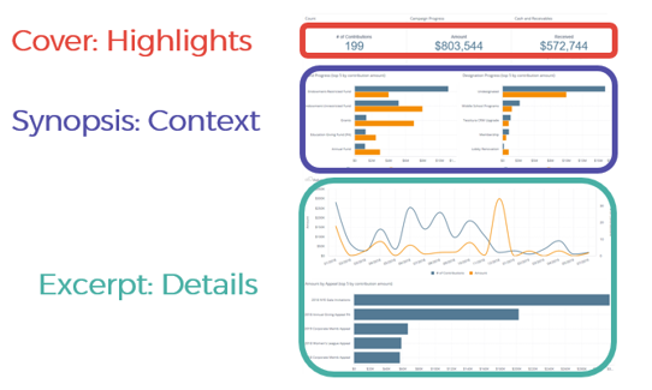BI and Analytics
Article
Insights & Innovation
a30ec488-2c1d-47a7-bda5-f4fe0cf167c0
6 min
https://edge.sitecorecloud.io/tessituraneab9a-tessiturane5642-staging-5396/media/Images/Stock-Photography/sticky-notes-patrick-perkins-unsplash-768x465.jpg?h=465&iar=0&w=768
Telling your data story
Once upon a time, in a world where data became insight…

Senior Consultant, Tessitura Network
Once upon a time, in a world where data became insight…
9/30/2020
6 min
“Data are just summaries of thousands of stories — tell a few of those stories to help make the data meaningful.”
— Chip and Dan Heath
You are standing in a bookshop, looking around at all of the different titles, trying to decide which one to buy. How do you make sure to choose well?
Well firstly, you might notice the name of a particular title or author, or perhaps you spot some cover art that draws you in. The cover of a book gives you a sense of what a story might be about, but really only provides the highlights. Once that’s captured your attention you might turn the book over and look at the back cover. There, the synopsis gives you more insight into what the book may contain, what other people are saying about it, and any other context to help inform what this story might involve. But to really understand the flavour of the book, get a sense of the writing style, and start to understand the characters, you crack the book open and read an excerpt. This allows you to get into the heart of the book before making a decision about whether or not you want to read the whole thing.
In the same way, when users are looking at a data visualisation in a tool like Tessitura Analytics, they want to be able to at a glance, understand what their dashboard is telling them; that way they can assess how deeply they want to engage with its story.
To continue this analogy, the cover of our book becomes the top line of data on your dashboard. (I’ll refer to “dashboards” from here on, but this could take whatever form your data visualisation tool uses, as long as it presents several data visualisations in a single report.) Typically the ‘cover’ will display in a simple numerical form, highlighting a few pieces of top line information. The ‘synopsis’ is the next few rows of data that give more context to the information on the dashboard. This is most likely in the form of a simple bar, column or line chart which provide a high-level break out of what went into those summary figures, or may even provide comparisons to other related figures. And finally, the ‘excerpt’ digs into the data more deeply, typically taking the form or a pivot table or more in-depth versions of our charts. It serves as a jumping off point for more data exploration, allowing users to really get into the story and drive decision-making.

If the dashboards you create aren’t telling stories, and instead are just a repository of information, you run the risk of people not engaging with the data, or ignoring it completely. Alternatively, in the same way stories passed down verbally evolve as they pass through different storytellers, we can find data to be misinterpreted, with carefully chosen excerpts of the story being taken and used, and the recipient of that data never hearing the full story.
Dashboards that tell stories naturally lead us down a path of further discovery, because they foster curiosity. And this kind of data exploration is healthy for your organisation, as it enables you to react creatively to business problems armed with insights from data. So how do we ensure we are telling our data story?
Dashboards that tell stories naturally lead us down a path of further discovery.
Six steps toward creating storytelling dashboards
1. Remain focused
They have one viewpoint, they tell one story, they don’t contain any data that deviates from the main purpose of the dashboard. If you’re using a flexible tool like Analytics, they will leverage functionality that allows for an in-depth view of a selected value; like jump-to dashboards and drill into functionality. Dashboards don’t have to be (and probably shouldn’t be) long or include a ton of widgets, they need to have a clear focus.
Ernest Hemingway, for example, famously wrote a powerful story in just one line: “For sale: baby shoes, never worn.” It only took six words to tell a gut-wrenching story. In the same way, a dashboard doesn’t have to have tons of charts to tell a story. A short, well curated dashboard is more impactful than a lengthy, poorly focused one.
2. Begin with business questions
If you ask someone what data they want on a dashboard, they’re likely going to give you some pretty simple answers or say that they don’t know, because they are unsure what the tools they have available to them can do. So, here are some questions you can use to start getting at the stories that your colleagues really want their data to tell:
- What are your goals?
- What are the measures and metrics for each goal?
- For the measures and metrics above that are tracked in your systems, describe where the data lives and how you access it.
- What questions do you ask about your business on a regular basis?
- Where do you currently find the answers to the questions above?
- What are the things that you’d like to see included on this dashboard?
The first questions — about goals, measures, and metrics — are fact finding questions, and the answers are not going to tell a story. As you get further down the list and begin to talk about the business, you’ll begin to outline the story that you want your dashboards to deliver. So with these questions combined, you should have the why, how and what to help you shape the story.
Dashboards don’t have to be long; they need to have a clear focus.
3. Make a plan with a wireframe
Wireframes are an effective way of designing your dashboard before you begin to build it. It’s a visual way to check that your dashboard contains all the data you need to tell your story before you invest time in building it in your system.
For the visual learners out there, sticky notes are my go-to for plotting out a dashboard on paper even before doing it in the tool itself. In today’s world with more and more people working from home, you can switch the sticky notes for tools such as Microsoft Whiteboard to create virtual sticky notes and whiteboards to wireframe your dashboards.
If you’ve not created a wireframe before, here’s how:
- Start with the questions you’re looking to answer (which you’ll have from Step 2, above).
- Next, prioritise those questions by identifying which ones best tell your story.
- Find the most appropriate data points to use to answer your questions. If you’re using Tessitura Analytics, you can reference the data dictionary to find a list of all of the data points available in each cube.
- Finally, it’s time to organize your data to ensure it’s telling your story in the right order (remember, we need a cover, synopsis and excerpt).
Wireframes are an effective way to design your dashboard before you begin to build it.
4. Take advantage of flexible filters
One of my favourite things about dashboards with flexible filters, like we see in Analytics, is the level of self-service you can have when it comes to reporting across an organization. Ad hoc reports or requests can be draining on resources, and unless these reports are pieced together somewhere down the line, they don’t really tell you an awful lot about progress or change over time.
Instead, flexible filters allow you to create a single dashboard for something that repeats (this could be yearly like a holiday show or monthly like KPIs). Simply hand this over to the department responsible for monitoring these results, and they can change the filters on the dashboard to reflect the new production or time period as and when they need. All the while, you can be confident that the results are being reported on in the same, consistent way, as it’s still the same dashboard.
Alternatively, they can use these filters to compare the results they see now to previous years and begin to spot trends in the data. Teams become empowered to access data, reporting becomes embedded across the organization, and you can sleep easy that people are using the right data consistently in the right way.
5. Build with visualisations, not just numbers, in mind
It’s important to remember that not everyone finds it easy to gather insights from data. While you may be successful at writing SQL code or using pivot tables to get to the insights you need, some people’s brains don’t work that way. Data visualisation tools provide an entry point for people of all abilities to access the high-level insights from a set of data, through a clear, concise visualisation.
So make sure you use your analytics tool in the way it was designed. It isn’t intended to be a simple extension of reports, displaying large lists of numbers for you to export to Excel; if you use Tessitura you already have other tools for that. Nor should it be a collection of pivot tables. It is a data visualisation tool for organising data, surfacing information, and enabling easy analysis and instant insights. Analytics for example even has a built in widget wizard to advise you on the best visualisation type for the data you have available, guiding you through the process of choosing the most effective way to tell your story. The tool itself is designed with visualisation in mind; use it to your advantage.
Not everyone finds it easy to gather insights from data. Data visualisation tools provide an entry point for people of all abilities to access high-level insights.
6. Know your audience
“There are two goals when presenting data:
convey your story and establish credibility.”
— Edward Tufte
We’ve covered the important aspects of telling our story, but there’s another important factor in telling any story: your audience. These are the people who will assess the credibility of your story and decide whether it’s an engaging or convincing read. You wouldn’t provide a board member with the same level of data as you would a junior assistant, as their roles and purpose within the organisation differ greatly. In the same way, children’s books and mystery novels are written with vastly different audiences in mind.
When creating a dashboard it’s important to consider who will be using it, so that you design it in the most appropriate and persuasive way for the user. As we mentioned earlier, consider their level of analytics experience; what type of visualisations are most effective to communicate with that individual based on their experience? The easier it is for them to have confidence in the data you provide and the story it’s telling, the more credible your data becomes.
• • •
If you follow these six guiding principles when creating your dashboards, you can embed data in decision making, empower all areas of your organisation to monitor performance against their goals, report consistently across the entire organisation and live happily ever after.
Top photo by Patrick Perkins on Unsplash
Topics
BI & Analytics

Kate Watson
Senior Consultant
Tessitura Network

Make your on-sales a success
Ticketing & Admissions / Digital / Customer Service / Technology
Eight tips to help you plan for a smooth on-sale

A contactless customer journey with a personal touch
Arts & Culture / Business Strategy / COVID-19 / Technology / Ticketing & Admissions
How Georgia Aquarium creates a visitor-focused experience